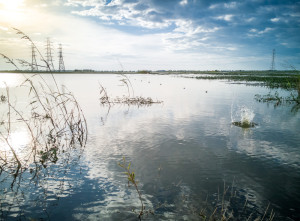
Official Media Partner
The housing crisis is requiring more sites to be unlocked to provide homes for the future, while environmental pressures are coming from increased flooding. To tackle the problem, investment in infrastructure is key. In the first of our series on Sustainable Drainage, UK Construction Media speaks with Dr David Smoker, Chair of the ICE SuDS Task Group and Business Development Director at ACO Water Management, about SuDS implementation.
Sustainable Drainage Systems (SuDS) are surface water management measures which mimic natural hydrological processes, offering benefits to water quality, biodiversity, public amenity and flood risk management.
With urban development, impermeable surfaces disrupt the natural hydrological pattern of evaporation from vegetated areas and permeation into the soil. This leads to localised flooding and water quality issues in receiving water courses. SuDS mimic nature and typically manage rainfall close to where it falls. SuDS can be designed to transport (convey) surface water, slow runoff down (attenuate) before it enters watercourses, provide areas to store water in natural contours and can be used to allow water to soak (infiltrate) into the ground or evaporated from surface water and lost or transpired from vegetation (known as evapotranspiration). Local flood risk management plans should consider all impacts of urban developments and, although they are often considered in isolation, SuDS should be considered as part of the response to increased impact of more frequent and larger rainfall events, along with catchment management and river flooding mitigation.

Policy, Procedures and Barriers
It is a requirement of most new developments in England, Scotland, Wales and Northern Ireland to consider and deliver SuDS as part of proposed surface water management measures. Across the four countries, the delivery mechanisms for SuDS and technical capabilities for SuDS are varied:
- Schedule 3 of the Flood & Water Management Act (2010), which would have provided established SuDS Approval Bodies (SABs) in each Lead Local Authority (LLFA), was not implemented in England
- Plans to implement schedule 3 of the Flood & Water Management Act (2010) in Wales are well advanced
- In Scotland, the Water Environment (Controlled Activities) Regulations have required SuDS for new developments since 2006, and SuDS are routinely installed in new developments
- Non-statutory SuDS technical guidance was developed in England, Northern Ireland and Wales
- LLFAs made statutory consultee on surface water management, including SuDS, in major developments in England and Wales
- In Northern Ireland, there is no automatic right to connect to the public sewer network (Sewerage Services Act, 2016) and some SuDS components can be adopted by Northern Ireland Water
- Water UK, the UK water industry body, is considering embedding a SuDS standard for components that sewerage undertakers can adopt within the unifying adoption document ‘Sewers for Adoption 8’
The variation in policy and legislation surrounding SuDS delivery, in combination with differing national and local governmental organisational structures, funding and skills, is often cited as a challenge to the delivery of successful SuDS (e.g. as found in the Chartered Institute of Water and Environmental Management (CIWEM)’s report, A Place for SuDS, 2017).
In England, policies and law concerning SuDS have continue to develop, with variable levels of implementation following the introduction of the Flood and Water Management Act (2010). Evidence from the CIWEM Big SuDS Survey (2017) states that the vast majority of respondents involved in SuDS delivery consider current SuDS policy ineffective and that the full benefits of SuDS are not being realised. However, the greatest barrier to SuDS delivery – commonly reported by housebuilders, practitioners and authorities alike – is the lack of a single adopting body or clear route for adoption of SuDS in new developments. In some cases, these challenges are being overcome by early and effective engagement from stakeholders that desire SuDS.
SuDS in the planning process

The Government’s housing ambition of one million homes delivered over the course of this Parliament, as outlined in the Housing and Planning Act (2016), will increase pressure on potable water supplies, urbanisation (and the associated risk of surface water flooding) and could lead to the increased fragmentation of habitats in our urban centres. Consideration of SuDS early on in the masterplanning process, prior to any outline design, potentially as part of pre-application discussions can be extremely effective in combatting such pressures. By working collaboratively and engaging early in the development planning process, developers, local planning authorities, LLFAs, Internal Drainage Boards (IDBs) , highways authorities, Water and Sewer Companies (WaSCs), other utilities providers, landowners and the public, can integrate effective water management techniques into new and existing communities. This principle is enshrined in and expanded on in the CIRIA C753 SuDS Manual (Part B).
In order to gain all the benefits that SuDS provide, SuDS design must be considered at the very start of the feasibility stages of a project and must also be factored in prior to land purchase. If SuDS are integrated into the vision and layout for the development, they will provide many opportunities to add value, character and desirability to a development. If the layout of a proposed SuDS scheme can be agreed at the conceptual masterplanning stage, then iterative design processes can exploit opportunities and overcome constraints by refining the design to make the best use of available space within a development to deliver a high-quality integrated water management solution.
SuDS can also play a part in mitigating the requirements for future infrastructure improvements (e.g. reducing the quantity of surface water entering public drainage networks, hence reducing the risk of foul water flooding to homes and property and removing, or reducing, the need for network capacity enhancements).
Good outcomes are underpinned by due consideration to the layout, function and land-take from the outset, to avoid designers having to effectively squeeze and retrofit lesser quality measures into the drainage design.
The ICE / ACO SuDS Task Group

The SuDS Task Group, sponsored by ACO Technologies, brought together SuDS practitioners, engineering consultants and academics to ascertain what the barriers to SuDS implementation are and how they may be overcome. A survey of over 400 SuDS professionals identified the need for ‘route maps’ to link to the most up-to-date information and guidance. One of the core outputs of the task group has therefore been the development of a suite of SuDS route maps. There is a wealth of high-quality resources and information relating to SuDS design and delivery – notably the CIRIA C753 SuDS Manual and the supportive community susdrain. The ICE SuDS Task Group wanted to draw together all relevant resources into one single place, to provide professionals and stakeholders involved in SuDS delivery a clear, easy to follow process for the delivery of SuDS and signposting to relevant resources.
The route maps serve two functions:
- Outlining the processes and stages involved in SuDS delivery (Outline Design, Detailed Design, Adoption, Maintenance and Retrofitting).
- Providing links to other sources of information and resources to enable professionals to design, deliver, adopt and maintain SuDS.
The downloadable pdf version is available on the ICE website at www.ice.org.uk/sudsroutemaps.
To read the SuDS special in full, click here.
UK Infrastructure Show 2018: register as a delegate here
If you would like to read more articles like this then please click here.
The post What are SuDS? appeared first on UK Construction Online.
Walang komento:
Mag-post ng isang Komento